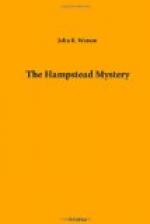The large open space between the house and the fir plantation had once been laid out as an Italian garden at the cost of much time and money, but Sir Horace Fewbanks had lacked the taste or money to keep it up, and had allowed it to become a luxuriant wilderness, though the sloping parterres and the centre flowerbeds still retained traces of their former beauty. The small lake in the centre, spanned by a rustic hand-bridge, was still inhabited by a few specimens of the carp family—sole survivors of the numerous gold-fish with which the original designer of the garden had stocked the lake.
Sir Horace Fewbanks had rented Riversbrook as a town house for some years before his death, having acquired the lease cheaply from the previous possessor, a retired Indian civil servant, who had taken a dislike to the place because his wife had gone insane within its walls. Sir Horace had lived much in the house alone, though each London season his daughter spent a few weeks with him in order to preside over the few Society functions that her father felt it due to his position to give, and which generally took the form of solemn dinners to which he invited some of his brother judges, a few eminent barristers, a few political friends, and their wives. But rumour had whispered that the judge and his daughter had not got on too well together—that Miss Fewbanks was a strange girl who did not care for Society or the Society functions which most girls of her age would have delighted in, but preferred to spend her time on her father’s country estate, taking an interest in the villagers or walking the country-side with half a dozen dogs at her heels.




